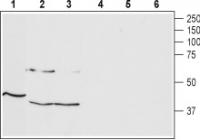Trhr Rabbit Polyclonal Antibody
Other products for "Trhr"
Specifications
| Product Data | |
| Applications | IF, WB |
| Recommended Dilution | WB: 1:200-1:2000; FC: 1:50-1:600 |
| Reactivities | Human, Mouse, Rat |
| Host | Rabbit |
| Clonality | Polyclonal |
| Immunogen | Peptide CKQKPTEKAANYS, corresponding to amino acid residues 337-349 of rat Thyrotropin-releasing hormone receptor 1 (Accession Q01717). Intracellular, C-terminus. |
| Formulation | Lyophilized. Concentration before lyophilization ~0.8mg/ml (lot dependent, please refer to CoA along with shipment for actual concentration). Buffer before lyophilization: Phosphate buffered saline (PBS), pH 7.4, 1% BSA, 0.05% NaN3. |
| Purification | Affinity purified on immobilized antigen. |
| Conjugation | Unconjugated |
| Storage | Store at -20°C as received. |
| Stability | Stable for 12 months from date of receipt. |
| Gene Name | thyrotropin releasing hormone receptor |
| Database Link | |
| Background | Thyrotropin-releasing hormone (TRH), is a widely distributed tripeptide which acts as a hormone, a paracrine regulatory factor and a neurotransmitter/neuromodulator; it is expressed in many parts of the brain as well as in various peripheral tissues. In the hypothalamus, TRH is secreted from the paraventricular nucleus (VPN) by TRH neurons prior to a post-translational processing from its precursor, pro-TRH. A key player in the regulation of the hypothalamus-pituitary-thyroid (HPT) axis, TRH is released into the hypophyseal portal circulation of the median eminence and reaches the pituitary, where it binds to TRH receptors, thereby stimulates the secretion of tyrothropin (thyroid-stimulating hormone; TSH). TSH, in turn, affects the thyroid to produce T4 which is subsequently converted into its biologically-active analog, T3 - a negative mediator of TRH. In the tanycytes, ependymal cells of glial origin located in close proximity to the VPN, T4 is converted to T3 by the enzyme deiodinase II (dio2) - a counterpart to deiodinase III (dio3) which conversely inactivates the above mentioned thyroid hormones, thus so indirectly promotes the production of TRHs. TRH receptor 1 (TRH-R1), the only identified TRH receptor in humans, is a G protein-coupled receptor (GPCR) abundant in the anterior pituitary, neuroendocrine system, autonomic nervous system and the visceral regions of the brain. Like all members of GPCRs, TRH receptor has seven transmembrane domains, and extracellular N-terminus and an intracellular C-terminal tail. TRH receptor couples Gq upon activation which in turn leads to the activation of phospholipase C. From a behavioral aspect, it was shown that TRH-coupled TRH-R1 increases cognitive arousal by directly exciting the sleep/wake system in the lateral hypothalamic area, and inhibits seizure activity in the hippocampus by facilitating GABA release, whereas its deficiency, as observed in mutant model mice, is linked to growth retardation, depression, and anxiety-like behavior. |
| Synonyms | MGC141920; TRH-R |
| Reference Data | |
Documents
| Product Manuals |
| FAQs |
{0} Product Review(s)
0 Product Review(s)
Submit review
Be the first one to submit a review
Product Citations
*Delivery time may vary from web posted schedule. Occasional delays may occur due to unforeseen
complexities in the preparation of your product. International customers may expect an additional 1-2 weeks
in shipping.






























































































































































































































































 Germany
Germany
 Japan
Japan
 United Kingdom
United Kingdom
 China
China




